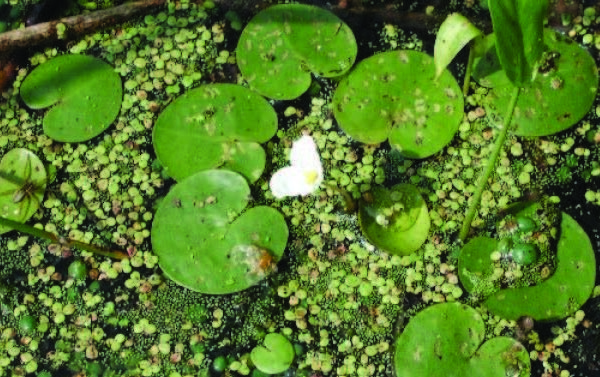European Frog-bit

Species at a Glance
European frog-bit (Hydrocharis morsus-ranae) is a free-floating aquatic plant that resembles a miniature water lily. It has been found in the Great Lakes since the 1930s, but is now spreading inland into streams and lakes within the basin. The dense floating mats formed by European frog-bit restrict available sunlight and nutrients, displace native plant species, reduce biodiversity, and impact water flow.
Species Description
European frog-bit is an herbaceous, annual, aquatic plant that can reach 20 cm (8 in) in length. The thick, leathery leaves are small (1.5-6.5 cm [0.6-2.5 in] long), heart-shaped, and occur in clumps that are not anchored to the bottom sediment. A dark purplish-red spongy coating is present on the underside of the leaves, allowing the plant to float on the water’s surface. Flowers are small, white, and showy, about 1 cm (0.4 in) in length. Each flower has three petals and a yellow center which show
up in early summer. While water lily species may be confused with European frog-bit, water lily flowers are much larger, with more than three petals. Stem-like extensions called stolons run from the center of the plant to produce juvenile plants. These stolons also produce turions (vegetative winter buds) that break free and sink to the water bottom to lie dormant for the winter.
Native & Introduced Ranges
Native to Europe and northern Asia, European frog-bit was introduced intentionally in the United States as a commercial ornamental that escaped cultivation and spread to the Canadian shorelines of Lake Erie, Lake Ontario, the St. Lawrence River in New York, and Lake Champlain in Vermont. Populations are also present in Michigan, New Jersey, Ohio, and Washington. This species was first confirmed in Pennsylvania in Warren County in 2013, and has also been found in Mercer County.
Biology & Spread
Most populations of European frog-bit tend to be dominated by only one sex, and therefore it seldom produces seeds. Instead it relies on plant fragments or turions to spread to new areas. A single plant can produce 100 to 150 turions in one season, which float to the surface and begin to grow in the spring. It can also hitchhike on boats, trailers, waterfowl, and flowing currents, and be spread to new areas. European frog-bit can also be spread as humans purchase it as an aquarium plant for water gardens.
Habitat
Preferring quiet, still, calcium-rich areas, the European frog-bit is typically found in marshes, fens, swamps, backwaters, bays, sheltered coves, poorly drained ditches, and slow-moving shorelines of rivers, streams, and lakes.
Environmental Impact
European frog-bit populations can expand rapidly, allowing them to overtake wetlands with dense mats of vegetation that decrease the amount of nutrients, dissolved oxygen, and light penetration available to native vegetation attempting to grown beneath, often making it the dominant species in wetlands. European frog-bit can also deplete oxygen levels by limiting water circulation and increasing decomposition of dead plants, potentially causing fish and other aquatic organism kills. These mats can also change water hydrology, water quality, and inhibit the movement of waterfowl and fish, negatively affecting the ecosystem. However, some studies show that European frog-bit can serve as a food source for some types of water birds, fish, and insects.
Prevention & Control
Once established, European frog-bit can be very difficult and costly to control and most solutions are only temporary. Mechanical harvesting, chemicals, and biological agents are three common methods suggested to control European frog-bit. Mechanical harvesting can have significant negative impacts on aquatic ecosystems. Hand removal can provide limited, or temporary relief. Chemicals such as endothal and diquat have been used as effective controls in ditches, however chemical treatments are not target-specific and can eliminate other aquatic plants, including beneficial species. Biological controls are also not target-specific, and to date there are no classical biological control organisms in development or released for European frog-bit.
The best way to manage European frog-bit is to prevent its spread into new areas. Always remove visible mud and plants before leaving a water body. Eliminate water from all equipment before transporting to new locations. Clean gear and equipment with either hot water (104° F or 40° C), or salt water OR let dry thoroughly for at least five days before entering a new water body. When choosing plants for a pond or water garden, purchase from a licensed nursery and choose regionally-native or non-invasive plants. Check with your state natural resource agency to confirm which plants to avoid for your region.
References:
Zhu, B. and Rudstam, L.G. 2014. Shading as a Control Method for Invasive European Frogbit (Hydrocharis morsus-ranae L.). PLoS ONE. 9. E98488. 10.1371/journal.pone.0098488; New York Sea Grant. 2007. European frog-bit (Hydrocharis morsus-ranae)-Floating Invader of Great Lakes Basin Waters. NYSG Invasive Species Factsheet Series: 07-1; Global Invasive Species Database (GISD) 2015. Species profile Hydrocharis morsus-ranae; Nault, M.E. and A. Mikulyuk. 2009. European Frog-bit (Hydrocharis morsus–ranae): A Technical Review of Distribution, Ecology, Impacts, and Management. Wisconsin Department of Natural Resources Bureau of Science Services, PUB-SS-1048 2009. Madison, Wisconsin, USA.



